|
|
|
Sort Order |
|
|
|
Items / Page
|
|
|
|
|
|
|
| Srl | Item |
| 1 |
ID:
129145
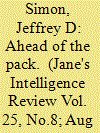

|
|
|
| 2 |
ID:
158748
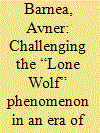

|
|
|
| 3 |
ID:
132361
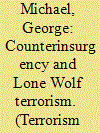

|
|
|
|
|
| Publication |
2014.
|
| Summary/Abstract |
This essay examines strategies to counter the threat of lone wolf terrorism. Lone wolves implement a tactical approach dubbed "leaderless resistance," which has become popular in several extremist subcultures. Although most episodes of lone wolf terrorism have not been highly destructive, there are notable exceptions that have claimed a substantial number of victims. The lone wolf trend should be contextualized in the evolution of conflict and strategy in which smaller and smaller entities figure prominently. Elements of the counterinsurgency doctrine can be applied to lone wolf terrorism. A comprehensive counterterrorism strategy must prepare for the prospect of lone wolf terrorism because of the increasing number of small-scale attacks, the large number of soft targets in contemporary society, and the potential damage that individuals can cause with the use of weapons of mass destruction.
|
|
|
|
|
|
|
|
|
|
|
|
|
|
|
|
| 4 |
ID:
152885
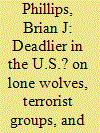

|
|
|
|
|
| Summary/Abstract |
Scholars, politicians, and pundits increasingly suggest lone wolf terrorists are substantial threats, but we know little about how dangerous these actors are—especially relative to other terrorist actors. How deadly are lone actor terrorists? A growing body of empirical research focuses on terrorist organizations, but similar work on lone actors is sparse. Furthermore, attempts to explicitly compare these or other types of terrorist actors are almost non-existent. This article considers theoretical arguments for why lone wolves ought to be especially lethal. However, it presents an argument for why terrorist groups should generally be more lethal. This argument is conditional upon the environment in which actors operate. Lone wolves should only be more deadly in states with especially strong counterterrorism capacity. The article uses data on terrorist attacks in fifteen developed countries, 1970–2010, to compare the lethality of terrorist acts. Around the world, attacks by organizations tend to be far more lethal than attacks by other actors. In the United States, however, lone wolves are generally the more lethal terrorist actors. This is argued to be because the robust counterterrorism capacity makes organized terrorism more difficult to accomplish.
|
|
|
|
|
|
|
|
|
|
|
|
|
|
|
|
| 5 |
ID:
168898
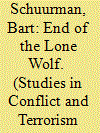

|
|
|
|
|
| Summary/Abstract |
This research note argues that the “lone wolf” typology should be fundamentally reconsidered. Based on a three-year empirical research project, two key points are made to support this argument. First, the authors found that ties to online and offline radical milieus are critical to lone actors' adoption and maintenance of both the motive and capability to commit acts of terrorism. Second, in terms of pre-attack behaviors, the majority of lone actors are not the stealthy and highly capable terrorists the “lone wolf” moniker alludes to. These findings not only urge a reconsideration of the utility of the lone-wolf concept, they are also particularly relevant for counterterrorism professionals, whose conceptions of this threat may have closed off avenues for detection and interdiction that do, in fact, exist.
|
|
|
|
|
|
|
|
|
|
|
|
|
|
|
|
| 6 |
ID:
151341
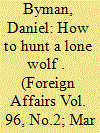

|
|
|
|
|
| Summary/Abstract |
In the last two years, “lone wolf” jihadists seemed to emerge as the new face of terrorism. In December 2015, husband and wife Syed Rizwan Farook and Tashfeen Malik attacked [3] a Christmas party held by Farook’s employer, the San Bernardino County Department of Public Health, killing 14. In June 2016, Omar Mateen killed [4] 49 people at a gay nightclub in Orlando, Florida—the deadliest attack on U.S. soil since 9/11. And in July, Mohamed Lahouaiej Bouhlel drove a truck [5] through a Bastille Day celebration in Nice, killing 86 people.
|
|
|
|
|
|
|
|
|
|
|
|
|
|
|
|
| 7 |
ID:
132359
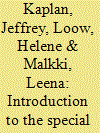

|
|
|
|
|
| Publication |
2014.
|
| Summary/Abstract |
Lone wolf and autonomous cell violence is as old as time itself. Phineas, the biblical figure who might well be considered the archetypical Lone Wolf (Numbers 25:1-9) is credited with averting the wrath of God from the Hebrews by taking it upon himself to murder an Israelite man and a Midianite woman whose miscegenatistic coupling threatened the survival of the Hebrew people. Phineas' act was cited by the Sicarii, a radical offshoot of the 1st-century Zealots, as the inspiration for the doomed uprising against Roman rule, which ultimately led to the expulsion of the Jewish people from the Holy Land. In recent years, Phineas inspired eponymous organizations or networks in the American Racist Right and the Israeli Radical Right. 2 The "Lone Avenger" motif has appeared in every era and in virtually every culture in the world.
|
|
|
|
|
|
|
|
|
|
|
|
|
|
|
|
| 8 |
ID:
142530
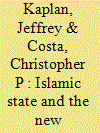

|
|
|
|
|
| Summary/Abstract |
This article focuses on the apocalyptic zeitgeist of the Islamic State through the lens of what we call the New Tribalism. It finds that IS emerged from the Al Qaeda (AQ) milieu, but soon split with AQ as the messianic excitement surrounding Al-Baghdadi and his teachings grew. In common with previous millennial/messianic movements in all three “Peoples of the Book”—Judaism, Christianity, and Islam—IS soon evolved beyond the laws of the normative faith (antinomianism). We hold that for this reason, despite its claims of faith and fealty, IS has left the Islamic Umah behind, becoming a malign sectarian group of its own whose dynamism and successes are attracting a global audience and support from Muslims in almost every country. This helps to explain such abhorrent practices as forced conversion, sexual servitude, the destruction of historic artifacts, and mass executions. We find that the American invasion of Iraq was the vital first step in a series of events, which gave birth to IS. A thorough review of IS history and political culture traces these historic moments in time.
|
|
|
|
|
|
|
|
|
|
|
|
|
|
|
|
| 9 |
ID:
132370
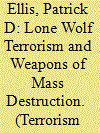

|
|
|
|
|
| Publication |
2014.
|
| Summary/Abstract |
Today, the specters of lone wolves and autonomous cells acquiring and using chemical, biological, radiological, and nuclear (CBRN) weapons of mass destruction, whether in their traditional military forms or the more non-traditional industrial forms, seems less far-fetched. Fortunately, military CBRN agents and weapons are not normally accessible to lone wolves or autonomous cells and are often located in highly secured areas. Therefore, lone wolves and autonomous cells may be drawn to materials similar to CBRN located in less secure areas. These commonplace industrial chemicals, biological contaminants, and radioactive materials could be used to cause disruptions or mass casualties. The dual use nature of these materials and technologies enables them to be turned into weapons and delivered by nonmilitary means. Future "over-the-horizon" threats, such as the proliferation of new biotechnologies and amateur do-it-yourself capabilities, pose a risk that lone wolves could develop weapons at a time when travel, access to knowledge, and dual-use technologies, in the globalizing environment, make lone wolf terrorists more dangerous. Thus, the author explores existing countermeasures, such as laws, strategies, passive and active measures designed to stop these dangerous threats. In particular, capabilities to prevent, protect, respond, and recover from CBRN terrorist acts are examined.
|
|
|
|
|
|
|
|
|
|
|
|
|
|
|
|
| 10 |
ID:
169934
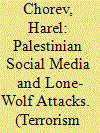

|
|
|
|
|
| Summary/Abstract |
This article examines the impact of social media on the wave of Palestinian lone-wolf attacks against Israelis from October 2015 through September 2016. My principal argument is that social media played an important role in shaping the identity, perceptions, and behavioral patterns of dozens of assailants, and was key in creating the dynamic that ultimately characterized both the spreading of the idea of lone-wolf attacks and its execution. Social media reflected reality on the ground while simultaneously nourishing, amplifying, and escalating the situation by providing a platform for the emergence of new sources of authority, including an online subculture with distinct codes and pseudo-ritual patterns to support assailants. Social media also contributed substantially to shaping the contagious character of the attacks, and their capacity to persist without direct organizational guidance, following a typical epidemiological dynamic of spread, containment, and preservation.
|
|
|
|
|
|
|
|
|
|
|
|
|
|
|
|
| 11 |
ID:
132364


|
|
|
|
|
| Publication |
2014.
|
| Summary/Abstract |
After discussing the extent to which the period from 1878-1934, with its frequent incidents of anarchist assassinations and bombings, can be considered the classic age of "lone wolf" or leaderless terrorism, this article focuses on four acts of anarchist violence and police and government responses to this violence. The four cases are the 1896 bombing of a Corpus Christi procession in Barcelona, the 1901 assassination of President McKinley, a 1902 bombing in Livorno (Leghorn) Italy, and the 1912 attempted assassination of Italian King Victor Emmanuel III. Confronted by these violent acts, the authorities resorted to two basic policies that might be referred to as "micro" and "macro" approaches. The macro approach was to launch massive crackdowns, arrest hundreds if not thousands of suspects (in some cases torturing them), and pass repressive legislation limiting freedom of the press, freedom of association, and freedom of assembly in order to discover the guilty terrorists and to squelch anarchist propaganda and organized activity. The micro approach was to focus on improving the intelligence capacity of the police by modernizing and expanding it, and creating or professionalizing the protective service for government ministers and heads of state.
|
|
|
|
|
|
|
|
|
|
|
|
|
|
|
|
| 12 |
ID:
175717
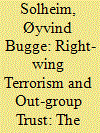

|
|
|
|
|
| Summary/Abstract |
Terrorist attacks often lead to public backlashes. Following the attacks on July 22, 2011 in Norway, Norwegians showed support for democratic values such as “openness,” “democracy,” and “tolerance” in the public debate and in the commemorations across the country. They also reported higher out-group trust. This paper explores two possible reasons for this increase in trust using a unique panel fielded before and right after the attacks. The first is that cognitive dissonance led people to dissociate from the terrorist and his ideology. The second is that the increase in trust was a response to the public backlash after the attacks. The increase in trust was not caused by cognitive dissonance. Rather, people who were already positive towards immigration, or who saw positive effects of the attacks, became more trusting than others did, and Progress Party supporters increased their trust less than others. These findings are interpreted as a response to the attacks and the political characteristics of the backlash. The study concludes by discussing implications for our understanding of the different consequences of attacks for the terrorists’ imagined constituencies and for the broader public.
|
|
|
|
|
|
|
|
|
|
|
|
|
|
|
|
| 13 |
ID:
163201
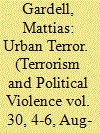

|
|
|
|
|
| Summary/Abstract |
White racist serial killer Peter Mangs is the most politically conscious lone wolf terrorist Sweden has seen thus far. Adopting the tactics of Joseph Paul Franklin to the city of Malmö, Mangs committed at least three murders and twelve murder attempts between 2003 and 2010. Well-versed in white power literature and leaderless resistance tactics, Mangs aimed at “igniting a race war” by shooting Black, Muslim, and Roma citizens to amplify racialized tensions, grievances, and anxieties in the increasingly segregated city. Yet, Mangs is not included in any database of single-actor terrorism, as these depend on how a perpetrator or incident is defined by the police, the courts, and the media. In this case, Mangs’ political motives were ignored by everyone, except by people in the targeted communities and the white racist milieu. This fact highlights the importance of ethnographic methods to terrorism studies. Based on ten three-hour interviews with Mangs, an analysis of his own political writings, previously not known to the public, interviews with Mangs’ victims, their friends and relatives, and extensive fieldwork in Malmö among activists across the political spectrum, including people who hailed Mangs’ deeds as heroic, this essay explores the impact of urban lone wolf terrorism.
|
|
|
|
|
|
|
|
|
|
|
|
|
|
|
|
|
|
|
|
|